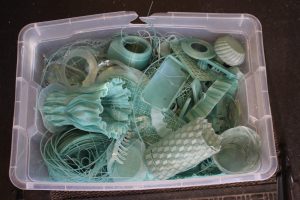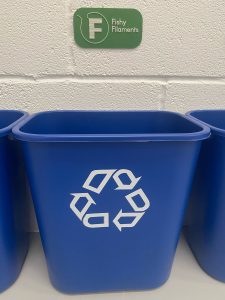Back in October 2020 we posed the question “Can you recycle recycled nylon ?”
Its the most common question we get asked once people understand the basics of what Fishy Filaments is doing.
Of course even before 2020 we knew the answer at a technical level was ‘yes’ – Nylon 6 is recyclable multiple times albeit with declining mechanical strength. However technical ability is not a reason to do it on its own.
We also need to know that we should do it.
In other words does it save carbon or cost carbon ?
In that post we talked about Closed Loop Production and our R² Marine Nylon® program. That program is now starting to provide to actionable results and we’re again leading the way on how to approach sustainable product development, from the raw material upwards.
To explain the R² Marine Nylon® program because there is no real way to make this simple
We recently received our preliminary Life Cycle Assessment for 3D printer filament production, 3D printing production waste capture and end-of-life product recycling from Exeter University Consulting. Produced in alignment with ISO 14040:2006 LCA principles and framework, this new report has provided us a powerful guide on how our materials might impact CO₂ emissions through mulitple cycles of use.
Carbon emissions calculations within Life Cycle Assessments can become very complex, very quickly as costs and benefits feedback into multi-stage, multi-stakeholder systems. We wanted to know if it was worth recycling our material any more times after the initial recovery from end-of-life fishing gear, but from a carbon emissions perspective alone. Whilst its a quantitative methodology what it can’t and didn’t attempt to do was provide us absolute data on Global Warming Potential for future activities. Working with academics from Exeter’s Environmental Sustainabiity Institute we had to create a model and do lab scale tests to fill in data gaps because we aren’t actually doing every step at full scale, just yet.
Comparing Like for Like ?
In contrast our first Life Cycle Assessment was relatively simple and its data pretty emphatic. Based on actual production data it showed that even with a margin of error, our net recycling process could recover valuable nylon from used nets in a carbon efficient manner. We quote 97-98% carbon saving vs well established global baselines for equivalent 1st use materials.
But as a company we also go on to add value to that material by conversion into a filament for 3D printing. That conversion process is not 100% efficient; it has energy costs and wastes. Additionally the 3D printing process itself is not 100% efficient and every production process results in an end-product with a finite lifespan.

We wanted to understand if it was carbon efficient to attempt to ‘close the loop’ on materials put aside as wastes or at end-of-life along that supply chain. This is very much a study on ‘should you?’ not ‘can you?’ as we undoubtedly can. Questions on the use of landfill or impacts of solid plastic wastes in the environment were not considered.
To be clear we can’t find any other 3D printing materials companies providing similar LCA data with which to compare this report’s findings, so the actual quantitative analysis has limited use as a performance indicator. What we are being informed by are the data relative to global baselines for the carbon impact of production of new nylon (contained in the GaBi and Ecoinvent databases). We think it looks good, but we have no idea how good it is until other companies start to release similar data.
And the results show ?
So we needed to know about the carbon impact of three elements that flow directly from our recycling of used nylon monofilament nets; 3D printing filament production and waste, 3D printing waste and end-of-life products, and to explore how the real world recovery of those materials might work together or, potentially, against each other, in two different closed loop scenarios.
The core findings were clear, albeit with a relatively high degree of uncertainty, and apply to both Porthcurno and Longships;
1) The carbon cost of filament extrusion is roughly 1.72 kg CO2-eq per kilo of nylon filament. This includes materials drying and incineration of wastes. In fact the bulk of this impact (almost 65%) is in waste disposal rather than actual filament production.
Recovery of filament production wastes back into our materials flows has a carbon cost, but that carbon cost appears significantly lower than 1st use equivalent products and is primarily attributable to the re-use of the majority of wastes that would otherwise have been incinerated.
For those in the trade; this strongly supports the use of an end-of-line granulator to feed QA/QC waste back into filament production, on carbon cost alone, because it is still reducing carbon cost vs brand new nylon. Using a 20% content of this second generation recycled material in a filament otherwise made of our micro-pellet products would reduce that filament’s carbon cost by around 59%.
2) We took this a stage further and looked at the carbon cost of recycling 3D printing wastes and end-of-life products (using some realistic assumptions) and it was found that recovery of these materials increased carbon efficiency still further. Replacing half the second generation material with third generation material (so 10% local 3DP wastes with 10% filament production wastes) reduces that filament’s carbon cost still further, for a total saving of 66%, despite these wastes requiring extra treatment through cycles of shredding and granulation to allow inclusion.
3) However in the case of end-of-life 3rd party products the uncertainty is higher, specifically in the area of the distance travelled to get the item back to us. And we just don’t have a strong handle on what end-of-life products might come back to us and from where. In this last scenario if we assume a near zero distance of travel (under 50km) for return to base then that too should be worth doing – on a carbon saving basis only. On its own this finding is a valuable endorsement of co-localisation of manufacturing and recycling, and it has a direct analogue with any local wastes from 3rd party injection moulding, such as sprues or incomplete mould fills.
So what does this tell us?
If we are to maximise the carbon savings attributable to recycling used monofilament fishing nets we should certainly recycle all our filament production wastes within the filament production cycle and include any clean, local, unmixed 3D printing waste that we can get back. It is realistic to return those clean production wastes as a routine action, especially where compounding is available, and for us to develop material recipies that integrate them as a means to drive down systemic carbon costs.
Also, our offer to customers to take back their production wastes and end-of-life products is now backed by data that strongly suggest that in many, but geographically limited, circumstances it should be carbon efficient to do so, rather than disposal by incineration.
We don’t yet know how much emissions impact we will actually have by closing the loop, but we now have a good deal more confidence that our Porthcurno and Longships products can reach a carbon efficient closed loop. We will depend on customers and designers for that to happen in the real world once our products exit our direct control and get embodied in products. The data also suggests a means to further drive down the carbon cost of the production of 0rCA®, our carbon-fibre infused material that provides Performance and Sustainability.
This is a valuable report that confirms our assertions that a carbon efficient closed loop can be established using end-of-life fishing nets as its prime source, and it’s findings will form a pillar for future product design and materials flow within the company’s operations.
We knew we could recycle recycled nylon. Now we have confirmation, on the basis of carbon efficiency, that we should recycle our 100% recycled Marine Nylon® wherever possible.
